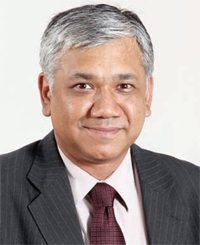MRINMOY PURKAYASTHA ASSOCIATE VICE PRESIDENT, MARKETING
Calsoft Labs, a wholly owned subsidiary of Europe’s leading Engineering and Technology Consulting group – ALTEN, provides services like embedded product engineering, software development and industrial design to product and technology companies in select market segments. Its target markets include aerospace & defense, automotive, consumer electronics, cloud computing, networking, storage and enterprise software.
Mrinmoy Purkayastha, associate vice president, marketing, and Somenath Nag, director, business development and marketing, ALTEN Calsoft Labs, talked to Abhishek Mutha of EFY about the different challenges they faced during the testing and verification in the embedded systems domain, like the testing of cloud technology on embedded systems and new technologies in digital TVs.

Q. What hardware challenges are faced while developing a cloud computing infrastructure?
A. Most of the users of cloud infrastructure face the challenge of optimizing the infrastructure for maximum performance. Basically, a cloud infrastructure consists of virtualized servers and storage devices. At the same time, it also needs other equipments which include application delivery controllers and load balancers to ensure that different applications are being routed to the right server and that they are getting the right response times. Band optimizers take care of the bandwidth optimization of the incoming/outgoing bandwidth. Apart from this, a good cloud management solution is very important to manage the cloud infrastructure.

Q. Tell us about the products on which you have worked with customers?
A. We have worked with a few customers through the entire evolution of application delivery controllers. Application delivery controllers used to be like simple pizza boxes, then they moved to chassis-based boxes with a number of blades in a single chassis, and today there are also versions which are completely virtualised called virtual ADCs (VADCs). They can be installed on any blade server and are essentially populated on demand.
We have also worked with customers on products like data centre switches for implementing load balancing technology and open flow technology to enable software-defined networking on them. These switches become part of the data centre fabric, and with open flow it is possible to essentially configure a network by using the open flow controller running on the data centre.
We understand cloud infrastructure quite well because of our experience. At the same time we have been working on the software side in enabling traditional on-premise applications or software to be moved to a cloud environment. So we understand the software side, which includes taking care of application monitoring and load balancing.
Q. What trends do you see emerging in embedded technology and cloud computing fields?
A. By looking at the connected world, it becomes clear that embedded and cloud computing are coming together to become part of a solution. On the embedded side, there are visions to support the migration of users to mobile and handheld devices. On the network side, innovation is done to support users coming into the network through different access technologies like wired or wireless. On the cloud side, answers are being found on how to respond to these users in the best possible way with the best performance response time.
Q. Give us some exciting examples of solutions combining both embedded and cloud computing?
A. A classic example of embedded and cloud coming together would be from the automotive industry. Traditionally, a car has a lot of ECUs that essentially collect the information from the sensors, provide the necessary information to the driver, and even store the information so that when the car is serviced at a service station, the technicians could retrieve the information for diagnostic purposes. Today, the scenario is that the information must be transmitted in realtime over a 3G or LTE network. The infotainment console is also connected all the time, and the information is sent over to a cloud server. So if there’s an issue with the car, a preventive diagnostic could be done.
With this concept of the connected car, we are trying to connect the embedded system within the car to a cloud server in such a way that an analysis could be performed when something is wrong with the vehicle and a real-time feedback could be provided to the driver.






